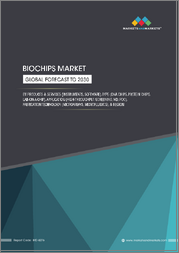
|
시장보고서
상품코드
1619229
세계의 마이크로어레이 시장 - 규모, 점유율, 성장 분석 : 제품 및 서비스별, 유형별, 용도별, 최종 용도별, 지역별 산업 예측(2024-2031년)Microarray Market Size, Share, Growth Analysis, By Product and Services (Consumables, Instruments), By Type (DNA Microarray, Protein Microarray), By Application, By End, By Region - Industry Forecast 2024-2031 |
||||||
마이크로어레이 세계 시장 규모는 2022년에 51억 달러로 평가되었고, 2023년 54억 9,000만 달러에서 2031년에는 99억 4,000만 달러로 성장하며, 예측 기간(2024-2031년)의 CAGR은 7.7%로 성장할 전망입니다.
마이크로어레이 기술은 유전체학 분야에서 중요한 역할을 하며, 다수의 핵산을 표면에 결합시킴으로써 하이브리드화를 통해 상대적인 핵산 서열 농도의 측정을 가능하게 합니다. 침강법과 조합함으로써 유전자 발현 수준의 정량이나 전사 인자 결합 부위의 특정에 특히 유용합니다. 마이크로어레이는 생물학자에게 풍부하고 복잡한 디지털 데이터를 제공하는 초기 기술 중 하나로 여전히 중요한 역할을 수행합니다. 광범위한 해석과 메타 해석을 지원함으로써 그 중요성은 점점 커지고 있습니다. Function Genomics Data Society가 확립한 MIAME 표준은 마이크로어레이 연구에서 고품질의 일관성 있는 보고를 보장하고 궁극적으로 향후 예측 기간 동안 마이크로어레이 기술에 대한 수요를 촉진합니다.
목차
소개
- 조사의 목적
- 조사 범위
- 정의
조사 방법
- 정보 조달
- 2차 데이터와 1차 데이터의 방법
- 시장 규모 예측
- 시장의 전제조건과 제한
주요 요약
- 세계 시장 전망
- 공급과 수요 동향 분석
- 부문별 기회 분석
시장 역학과 전망
- 시장 개요
- 시장 규모
- 시장 역학
- 성장 촉진요인과 기회
- 억제요인과 과제
- Porter's Five Forces 분석
주요 시장 인사이트
- 중요성공요인
- 경쟁도
- 주요 투자 기회
- 시장 생태계
- 시장의 매력 지수(2023년)
- PESTEL 분석
- 거시경제지표
- 밸류체인 분석
- 가격 분석
마이크로어레이 시장 규모 : 제품 및 서비스별 & CAGR(2024-2031)
- 시장 개요
- 소모품
- 기기
- 소프트웨어 및 서비스
마이크로어레이 시장 규모 : 유형별 & CAGR(2024-2031)
- 시장 개요
- DNA 마이크로어레이
- 단백질 마이크로어레이
- 기타
마이크로어레이 시장 규모 : 용도별 & CAGR(2024-2031)
- 시장 개요
- 연구 용도
- 창약
- 질병의 진단
- 기타 용도
마이크로어레이 시장 규모 : 최종 용도별 & CAGR(2024-2031)
- 시장 개요
- 조사 및 학술기관
- 제약·바이오테크놀러지 기업
- 진단 실험실
마이크로어레이 시장 규모 : 지역별 & CAGR(2024-2031)
- 북미
- 미국
- 캐나다
- 유럽
- 독일
- 스페인
- 프랑스
- 영국
- 이탈리아
- 기타 유럽
- 아시아태평양
- 중국
- 인도
- 일본
- 한국
- 기타 아시아태평양
- 라틴아메리카
- 브라질
- 기타 라틴아메리카
- 중동 및 아프리카
- GCC 국가
- 남아프리카
- 기타 중동 및 아프리카
경쟁 정보
- 상위 5개사 비교
- 주요 기업의 시장 포지셔닝(2023년)
- 주요 시장 기업이 채용한 전략
- 시장의 최근 동향
- 기업의 시장 점유율 분석(2023년)
- 주요 기업의 기업 프로파일
- 기업 개요
- 제품 포트폴리오 분석
- 부문별 점유율 분석
- 수익의 전년대비 비교(2021-2023)
주요 기업 프로파일
- Illumina, Inc.(USA)
- Agilent Technologies, Inc.(USA)
- Thermo Fisher Scientific, Inc.(USA)
- Merck KGaA(Germany)
- PerkinElmer, Inc.(USA)
- Arrayit Corporation(USA)
- Bio-Rad Laboratories, Inc.(USA)
- GE Healthcare(UK)
- Molecular Devices, LLC.(USA)
- Affymetrix(USA)
- RayBiotech Life, Inc.(USA)
- Full Moon BioSystem, Inc.(USA)
- CapitalBio Technology Co., Ltd.(China)
- Microarray Inc.(USA)
- QIAGEN(Netherlands)
- Roche NimbleGen(USA)
- Applied Microarrays(USA)
- bioMerieux SA(France)
- Discerna(USA)
- Gyros AB(Sweden)
결론과 권장사항
JHS 25.01.06Global Microarray Market size was valued at USD 5.1 billion in 2022 and is poised to grow from USD 5.49 billion in 2023 to USD 9.94 billion by 2031, growing at a CAGR of 7.7% during the forecast period (2024-2031).
Microarray technology remains pivotal in the genomics landscape, allowing for the binding of numerous nucleic acids to a surface, which facilitates the measurement of relative nucleic acid sequence concentrations through hybridization. This innovative approach is particularly valuable for quantifying gene expression levels and pinpointing transcription factor binding sites when paired with chromatin immunoprecipitation. As one of the earliest technologies offering biologists a wealth of complex digital data, microarrays continue to play a crucial role, especially with the advent of raw and processed data that supports extensive analysis and meta-analyses. The MIAME standards established by the Function Genomics Data Society ensure high-quality, consistent reporting in microarray research, ultimately driving demand for microarray technology in the upcoming forecast period.
Top-down and bottom-up approaches were used to estimate and validate the size of the Global Microarray market and to estimate the size of various other dependent submarkets. The research methodology used to estimate the market size includes the following details: The key players in the market were identified through secondary research, and their market shares in the respective regions were determined through primary and secondary research. This entire procedure includes the study of the annual and financial reports of the top market players and extensive interviews for key insights from industry leaders such as CEOs, VPs, directors, and marketing executives. All percentage shares split, and breakdowns were determined using secondary sources and verified through Primary sources. All possible parameters that affect the markets covered in this research study have been accounted for, viewed in extensive detail, verified through primary research, and analyzed to get the final quantitative and qualitative data.
Global Microarray Market Segmental Analysis
Global Microarray Market is segmented by product and services, type, application, end use and region. Based on product and services, the market is segmented into consumables, instruments and software and services. Based on type, the market is segmented into DNA microarray, protein microarray and others. Based on application, the market is segmented into research applications, drug discovery, disease diagnostics and others applications. Based on end use, the market is segmented into research and academic institutes, pharmaceutical and biotechnology companies and diagnostic laboratories. Based on region, the market is segmented into North America, Europe, Asia Pacific, Latin America and Middle East & Africa.
Driver of the Global Microarray Market
Global Microarray is a cutting-edge technology designed for high-throughput analysis of gene expression, enabling researchers to investigate the complexities of genomic data rapidly and efficiently. This driver provides an interface for seamless integration with existing bioinformatics pipelines, allowing users to preprocess, analyze, and visualize microarray data effortlessly. With its intuitive functionality, users can easily load raw data, apply normalization techniques, perform differential expression analysis, and generate insightful visualizations such as heatmaps and volcano plots. Furthermore, the driver supports various data formats and harmonizes with popular statistical packages, ensuring compatibility and fostering reproducibility in genetic research and clinical studies.
Restraints in the Global Microarray Market
Global Microarray is a powerful biotechnology company leveraging cutting-edge microarray technology for genomic analysis. However, its expansion is restrained by several factors, including regulatory hurdles associated with genetic testing and data privacy concerns. Furthermore, the high cost of microarray technology can limit accessibility for smaller laboratories and institutions, potentially stifling research innovation. The competitive landscape, with rapid advancements in alternative genomic sequencing technologies, poses an additional challenge to maintaining market leadership. Lastly, the reliance on skilled personnel and specialized training necessitates a continuous investment in human resources, which can strain operational budgets and affect long-term sustainability.
Market Trends of the Global Microarray Market
The global microarray market is experiencing dynamic trends driven by the need for personalized medicine and precision diagnostics. As the demand for genetic analysis and profiling escalates, advancements in genomics research and understanding of genetic variations are propelling microarray technology to the forefront. Additionally, the industry is witnessing a significant shift toward multiplexing and high-throughput analysis, allowing researchers to evaluate thousands of genes or proteins simultaneously, thereby enhancing efficiency and reducing costs. Furthermore, the focus on biomarker discovery and validation is intensifying, as microarrays play a crucial role in identifying potential biomarkers for early disease detection and targeted therapies, further propelling market growth.
Table of Contents
Introduction
- Objectives of the Study
- Scope of the Report
- Definitions
Research Methodology
- Information Procurement
- Secondary & Primary Data Methods
- Market Size Estimation
- Market Assumptions & Limitations
Executive Summary
- Global Market Outlook
- Supply & Demand Trend Analysis
- Segmental Opportunity Analysis
Market Dynamics & Outlook
- Market Overview
- Market Size
- Market Dynamics
- Drivers & Opportunities
- Restraints & Challenges
- Porters Analysis
- Competitive rivalry
- Threat of substitute
- Bargaining power of buyers
- Threat of new entrants
- Bargaining power of suppliers
Key Market Insights
- Key Success Factors
- Degree of Competition
- Top Investment Pockets
- Market Ecosystem
- Market Attractiveness Index, 2023
- PESTEL Analysis
- Macro-Economic Indicators
- Value Chain Analysis
- Pricing Analysis
Global Microarray Market Size by Product and Services & CAGR (2024-2031)
- Market Overview
- Consumables
- Instruments
- Software and Services
Global Microarray Market Size by Type & CAGR (2024-2031)
- Market Overview
- DNA Microarray
- Protein Microarray
- Others
Global Microarray Market Size by Application & CAGR (2024-2031)
- Market Overview
- Research Applications
- Drug Discovery
- Disease Diagnostics
- Others Applications
Global Microarray Market Size by End Use & CAGR (2024-2031)
- Market Overview
- Research and Academic Institutes
- Pharmaceutical and Biotechnology Companies
- Diagnostic Laboratories
Global Microarray Market Size & CAGR (2024-2031)
- North America (Product and Services, Type, Application, End Use)
- USA
- Canada
- Europe (Product and Services, Type, Application, End Use)
- Germany
- Spain
- France
- UK
- Italy
- Rest of Europe
- Asia Pacific (Product and Services, Type, Application, End Use)
- China
- India
- Japan
- South Korea
- Rest of Asia-Pacific
- Latin America (Product and Services, Type, Application, End Use)
- Brazil
- Rest of Latin America
- Middle East & Africa (Product and Services, Type, Application, End Use)
- GCC Countries
- South Africa
- Rest of Middle East & Africa
Competitive Intelligence
- Top 5 Player Comparison
- Market Positioning of Key Players, 2023
- Strategies Adopted by Key Market Players
- Recent Developments in the Market
- Company Market Share Analysis, 2023
- Company Profiles of All Key Players
- Company Details
- Product Portfolio Analysis
- Company's Segmental Share Analysis
- Revenue Y-O-Y Comparison (2021-2023)
Key Company Profiles
- Illumina, Inc. (USA)
- Company Overview
- Business Segment Overview
- Financial Updates
- Key Developments
- Agilent Technologies, Inc. (USA)
- Company Overview
- Business Segment Overview
- Financial Updates
- Key Developments
- Thermo Fisher Scientific, Inc. (USA)
- Company Overview
- Business Segment Overview
- Financial Updates
- Key Developments
- Merck KGaA (Germany)
- Company Overview
- Business Segment Overview
- Financial Updates
- Key Developments
- PerkinElmer, Inc. (USA)
- Company Overview
- Business Segment Overview
- Financial Updates
- Key Developments
- Arrayit Corporation (USA)
- Company Overview
- Business Segment Overview
- Financial Updates
- Key Developments
- Bio-Rad Laboratories, Inc. (USA)
- Company Overview
- Business Segment Overview
- Financial Updates
- Key Developments
- GE Healthcare (UK)
- Company Overview
- Business Segment Overview
- Financial Updates
- Key Developments
- Molecular Devices, LLC. (USA)
- Company Overview
- Business Segment Overview
- Financial Updates
- Key Developments
- Affymetrix (USA)
- Company Overview
- Business Segment Overview
- Financial Updates
- Key Developments
- RayBiotech Life, Inc. (USA)
- Company Overview
- Business Segment Overview
- Financial Updates
- Key Developments
- Full Moon BioSystem, Inc. (USA)
- Company Overview
- Business Segment Overview
- Financial Updates
- Key Developments
- CapitalBio Technology Co., Ltd. (China)
- Company Overview
- Business Segment Overview
- Financial Updates
- Key Developments
- Microarray Inc. (USA)
- Company Overview
- Business Segment Overview
- Financial Updates
- Key Developments
- QIAGEN (Netherlands)
- Company Overview
- Business Segment Overview
- Financial Updates
- Key Developments
- Roche NimbleGen (USA)
- Company Overview
- Business Segment Overview
- Financial Updates
- Key Developments
- Applied Microarrays (USA)
- Company Overview
- Business Segment Overview
- Financial Updates
- Key Developments
- bioMerieux SA (France)
- Company Overview
- Business Segment Overview
- Financial Updates
- Key Developments
- Discerna (USA)
- Company Overview
- Business Segment Overview
- Financial Updates
- Key Developments
- Gyros AB (Sweden)
- Company Overview
- Business Segment Overview
- Financial Updates
- Key Developments



















